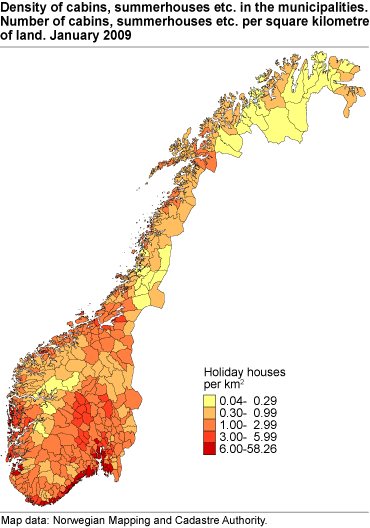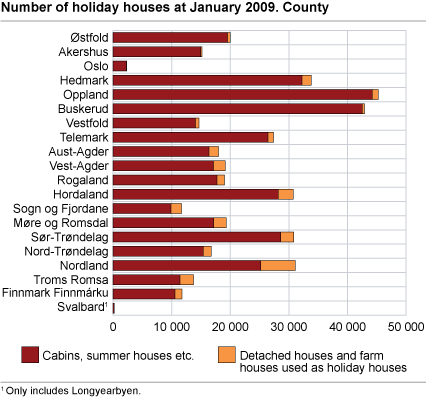Content
Published:
This is an archived release.
Most holiday houses in inner land municipalities
The inner land municipalities of Ringsaker, Trysil and Hol has most holiday houses - 6 316, 5 792 and 4 946 huts respectively. The next three municipalities are situated by the Oslofjord; Fredrikstad, Hvaler and Larvik, with 4 423, 4 293 and 4 160 holidays houses respectively.
Some municipalities single out with especially many holiday houses. The ranking list, measured in number of holiday houses per square kilometre, do however look quite different. Here, Tjøme municipality thrones on top, with more than 56 holiday houses per square kilometre. The list top is dominated by island- and coast municipalities that are quite small measured in area.
In all, 394 102 holiday houses are registered in Norway, distributed on a total land area of 305 470 square kilometres (Norwegian mainland). This equals to 1.29 holiday houses per square kilometre.
Most buildings in Hordaland
Hordaland county, with its 344 386 buildings, is the county with most buildings in Norway. Akershus and Rogaland counties are second and third, with 298 294 and 284 111 buildings respectively. The three counties with most buildings stands for 24 per cent of the total building stock measured in number of buildings.
Foundation for statisticsThe statistics are based on data from the Ground Property, Address and Building Register (GAB). The municipalities record data in the GAB. All buildings in Norway larger than 15 m2 are to be recorded in the register with a code for building type and coordinates. The statistics can include buildings that are torn down, burnt down or otherwise non-existing, if not reported to the municipality. Connected units are recorded as separate buildings when the units can be torn down independently of each other. A single dwelling in row houses and in semi-detached houses is recorded as one building. Improvement of the GAB registerMunicipalities clean their registers at frequent intervals to improve quality. As a result, buildings that were not classified one year are assigned their correct building type the following year. In addition, incorrectly classified buildings are assigned their correct building type code. The number of registered buildings in a municipality may therefore change from one year to the next. Conversion to new property registerAs of 5 November 2007 the municipalities will be transferred in groups from the Ground Parcel, Address and Building Register (GAB) to the new property register, Matrikkelen. All municipalities will be transferred by the end of April 2009. In connection with the conversion the municipalities have conducted several quality tests. This may have resulted in extra improvements in some municipalities. New area figures in 2008The National Mapping Authority has recalculated areas for land and freshwater in 2008. The new calculations are based on a more detailed map source. This has lead to changes in total areas for municipalities, and in figures for land and freshwater area. Changes in density of huts (huts per square kilometer) may hence be due to changes in figures for land area. |
Tables:
- Table 1 Existing building stocks at January 2009. County
- Table 2 Existing stock of residential buildings at January 2009. County
- Table 3 Existing stock of non-residential buildings at January 2009. County
- Table 4 Number of holiday houses at January 2009. County
- Table 5 Number of holiday houses per square kilometer, by municipality. January 2009
Contact
-
Jens Mathiesen
E-mail: jens.mathiesen@ssb.no
tel.: (+47) 40 81 13 98
-
Mona Takle
E-mail: mona.takle@ssb.no
tel.: (+47) 40 81 14 12


